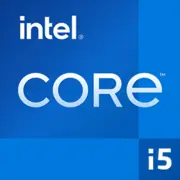Intel Core i5-12400T

Intel Core i5-12400T: コンパクトでエネルギー効率の良いシステムに最適な選択
2025年3月
2021年末に発売されたIntel Core i5-12400Tプロセッサは、性能とエネルギー効率のバランスを重視するユーザーにとって依然として有効な選択肢です。新しい世代のCPUが登場しても、このモデルは低TDPとコンパクトなシステムでの安定した動作により人気を維持しています。このチップがどのようなユーザーに適しているか、またどのように正しく組み込むべきかを見ていきましょう。
1. 主な仕様:妥協のないハイブリッドアーキテクチャ?
Alder LakeアーキテクチャとIntel 7プロセス
i5-12400Tは、Intelの最初のマスハイブリッドデザインであるAlder Lake(2021)をベースにしています。しかし、上位モデル(例:i5-12600K)とは異なり、このプロセッサには6つのパフォーマンスコア(Pコア)のみが搭載されており、効率コア(Eコア)はありません。これによりタスク管理は簡素化されますが、マルチスレッドの性能は制限されます。Intel 7プロセス(10nm Enhanced SuperFin)は、良好なエネルギー効率を提供し、TDPは35Wです。
クロック周波数とキャッシュ
Pコアの基本クロック周波数は1.8GHzで、ターボモードでは最大4.2GHzに達します。この幅は、アイドル時のエネルギー消費を抑え、負荷時に急速に加速することを可能にします。L3キャッシュの容量は18MBで、アプリケーションのレスポンスを向上させます。
統合グラフィックス
Intel UHD Graphics 730の統合GPUは、オフィス作業、4Kビデオ視聴、要求の少ないゲーム(例:MinecraftやCS:GOの低設定)に適しています。現代のAAAゲームには、専用グラフィックカードが必要です。
性能
- Geekbench 6: 2048(シングルコア) / 7476(マルチコア)。
- i5-12400(Tサフィックスなし)との比較では、マルチコアの差は約15%ですが、消費電力はほぼ半分です。
2. 対応マザーボード:LGA 1700ソケットとチップセットの選択
このプロセッサはLGA 1700ソケットを使用しており、600シリーズおよび700シリーズのチップセットをサポートしています:
- H610 — 予算重視の選択肢。基本的なビルドには適していますが、PCIe 4.0スロットやUSBポートの数は制限されています。例:ASUS Prime H610M-E(90〜110ドル)。
- B660/B760 — 最適な選択肢。DDR4/DDR5、PCIe 4.0、USB 3.2 Gen2をサポートしています。例:MSI PRO B760M-A WIFI DDR4(130〜150ドル)。
- H670/Z690/Z790 — i5-12400Tには過剰です。なぜなら、このチップはオーバークロックをサポートしていないからです。主に上位CPUへのアップグレード向けです。
重要! 一部の700シリーズマザーボード(例:Z790)は、Alder Lakeと互換性を持たせるためにBIOSのアップデートが必要です。購入前に互換性を確認してください。
3. メモリ:DDR4 vs DDR5 — どちらを選ぶべきか?
このプロセッサは両方のRAMタイプをサポートしています:
- DDR4-3200 — より安価ですが、ほとんどのタスクには十分です。16GB(2x8)のセットは50〜70ドルで入手可能です。
- DDR5-4800 — より高価(16GBは80〜100ドル)ですが、プロフェッショナルアプリケーション(レンダリング、エンコード)で5〜10%のパフォーマンス向上をもたらします。
アドバイス: オフィスPCやメディアセンターにはDDR4を選択してください。DDR5は、高負荷のソフトウェアを使用するワークステーションのみに推奨されます。
4. 電源ユニット:必要なワット数は?
TDPが35Wのため、このプロセッサは電源ユニットに対して要求が厳しくありません:
- ディスクリートグラフィックカードなしのシステム: 300〜400Wで十分です(例:be quiet! Pure Power 11 400W、60ドル)。
- NVIDIA RTX 3060級のグラフィックカードあり: 500〜600Wの電源ユニットをお勧めします(Corsair CX650M、80ドル)。
重要! 低TDPであっても、80+ Bronze以上の認証を受けた電源ユニットを選択してください。これにより、安定性と85%以上の効率が保証されます。
5. i5-12400Tの長所と短所
長所:
- エネルギー効率:ミニPCやパッシブ冷却システムに最適。
- PCIe 5.0およびDDR5のサポート(将来的に)。
- 低価格:150〜180ドル(新品、2025年)。
短所:
- Eコアがないため、マルチスレッド性能はRyzen 5 7600に劣る。
- 統合グラフィックスはAMD Ryzen 5 5600Gよりも弱い。
- オーバークロックをサポートしていない。
6. 使用シナリオ
- オフィス作業やウェブサーフィン: 複数のタブやオフィスアプリケーションとも容易に処理します。
- メディアセンター: HDMI 2.0経由で4K HDRデコード。
- 軽いゲーム: GTX 1660 Super級のGPUと組み合わせることで、FortniteやApex Legendsで60FPSを実現します。
- ホームサーバー: 低いエネルギー消費と仮想化のサポート。
実用例: ユーザーはi5-12400Tを用いてSilverstone ML05ケース(4.5リットル)にHTPCを組み立てました。システムは無音で、アイドル時の消費電力は25Wです。
7. 競合との比較
- AMD Ryzen 5 5600G(2021): 最高のグラフィックス(Vega 7)ですが、Geekbench 6のシングルコアは1580。価格:130〜160ドル。
- AMD Ryzen 5 7600(2022): より高い性能(シングルコア2250)、しかし高価(200〜220ドル)でDDR5が必要。
- Intel Core i5-13400T(2023): マルチコアでの性能向上は10〜15%ですが、価格が高い(190〜210ドル)。
結論: i5-12400Tは予算セグメントで優れており、特にエネルギー節約を重視する場合におすすめです。
8. ビルドに関するアドバイス
- クーラー: ボックス冷却で十分ですが、完全な静音性を求めるならNoctua NH-L9i(50ドル)を選択してください。
- ケース: ミニITX(例:Cooler Master NR200)またはコンパクトなMicro-ATX。
- ストレージ: SSD NVMeを必ず選択してください(例:Samsung 980 500GB、60ドル)。
- ネットワーク機能: マザーボードにWi-Fiがない場合は、PCIeアダプター(Intel AX200、25ドル)を追加しましょう。
9. 総括:i5-12400Tが適しているのはどのような人か?
このプロセッサは以下のユーザーにとって素晴らしい選択肢です:
- オフィスPC — 低いエネルギー消費と安定性。
- 家庭用シアター — 静かな動作と4Kサポート。
- コンパクトなビルド — 最小限の熱発生。
- 予算重視のゲーミングシステム — ディスクリートグラフィックカードと組み合わせて。
なぜこれなのか? 150〜180ドルで、現代的なアーキテクチャ、DDR5/PCIe 5.0のサポート、Windows 11との互換性が保証されます。ゲームでのFPSを最大限に求める場合や3Dモデルのレンダリングが不要であれば、i5-12400Tは3〜5年の良い投資になるでしょう。
基本
CPUの仕様
メモリ仕様
GPUの仕様
その他
ベンチマーク
他のCPUとの比較
ソーシャルメディアで共有する
または当サイトへのリンクを追加
<a href="https://cputronic.com/ja/cpu/intel-core-i5-12400t" target="_blank">Intel Core i5-12400T</a>